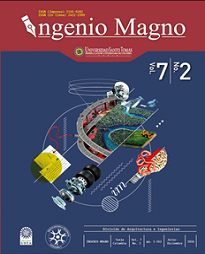Development of a filtration system using sintered materials as a means of filtration
Main Article Content
Abstract
Downloads
Article Details
DECLARATION OF ORGINIALITY OF SUBMITTED ARTICLE
With this document, I/We certify that the article submitted for possible publication in the institutional journal INGENIO MAGNO of the Research Center Alberto Magno CIIAM of the University Santo Tomás, Tunja campus, is entirely of my(our) own writing, and is a product of my(our) direct intellectual contribution to knowledge.
All data and references to completed publications are duly identified with their respective bibliographical entries and in the citations thus highlighted. If any adjustment or correction is needed, I(we) will contact the journal authorities in advance.
Due to that stated above, I(we) declare that the entirety of the submitted material is in accordance with applicable laws regarding intellectual and industrial property, and therefore, I(we) hold myself(ourselves) responsible for any complaint related to it.
If the submitted article is published, I(we) declare that I(we) fully relinquish publishing rights of the article to the University Santo Tomás, Tunja campus. As remuneration for this relinquishment of rights, I(we) declare my(our) agreement to receive two (2) copies of the edition of the journal in which my(our) article appears.
References
Chen, F., Ma, L., Shen, Q. y Zhang, L. (2011). Pore structure control of starch processed silicon nitride porous ceramics with near-zero shrinkage. Materials Letters, 65, 1410-1412.
Choo, K. H., Lee, H. y Choi, S. J. (2005). Iron and manganese removal and membrane fouling during UF in conjunction with prechlorination for drinking water treatment. Journal of Membrane Science, 267(1-2), 18-26.
Churchman, G., Askary, M., Peter, P., Wright, M., Raven, M. y Self, P. (2002). Geotechnical properties indicating environmental uses for an unusual Australian bentonite. Applied Clay Science, 20, 199-209.
Ćurković, L., Cerjan-Stefanović, Š y Filipan T. (1997). Metal ion exchange by natural and modified zeolites. Water Research, 31(6), 1379-1382.
Dabwan, A. H., Imai, D., Kaneco, S., Senmatsu, I., Nakahama, K., Katsumata, H. Suzuki, T. y Ohta, K. (2008). Water purification with sintered porous materials fabricated at 400°C from sea bottom sediments. Journal of Environmental Sciences, 20(2), 172-176.
De Sa, C., Benboudjema, F., Thiery, M y Sicard, J. (2008). Analysis of microcracking induced by differential drying shrinkage. Cement and Concrete Composites,30(10), 947-956.
Deffeyes, K. S. (1959). Zeolites in sedimentary rocks. International Journal of Sediment Research, 29(4), 602-609.
Dong, Y., Chen, S., Zhang, X., Yang, J., Liu, X. y Meng, G. (2006). Fabrication and characterization of low cost tubular mineral-based ceramic membranes for microfiltration from natural zeolite. Journal of Membrane Science, 281(1-2), 592-599.
Hajjaji, M., Kacim, S. y Boulmane, M. (2002) Mineralogy and firing characteristics of a clay from the valley of Ourika (Morocco). Applied Clay Science., 21, 203-212.
Hay, R. L. (1996). Zeolites and zeolitic reactions in sedimentary rocks. Geological Society of America (JournalSeek), 85, 1-122.
Li, Z., Jiang, W. T., Jean, J. S., Hong, H., Liao, L. y Lv, G. (2011). Combination of hydrous iron oxide precipitation with zeolite filtration to remove arsenic from contaminated water. Desalination, 280(1-3), 203-207.
Mecha, C. A. y Pillay, V. L. (2014). Development and evaluation of woven fabric microfiltration membranes impregnated with silver nanoparticles for potable water treatment. Journal of Membrane Science, 458, 149-156.
Mopoung, S., Sriprang, N. y Namahoot, J. (2014). Sintered filter materials with controlled porosity for water purification prepared from mixtures with optimal ratio of zeolite, bentonite, kaolinite, and charcoal. Applied Clay Science, 88-89, 123-128.
Mwabi, J., Adeyemo, F., Mahlangu, T., Mamba, B., Brouckaert, B., Swartz, C., Offringa, G., Mpenyana- Monyatsi, L. y Momba. M (2011). Household water treatment systems: A solution to the production of safe drinking water by the low-income communities of Southern Africa. Physics and Chemistry of the Earth, 36, 1120-1128.
Park, M. y Komarneni, S. (1997). Occlusion of KNO3 and NH4NO3 in natural zeolites. Zeolites, 18(2-3), 171-175.
Qin, S., Ma, F., Huang, P. y Yang, J. (2009). Fe (II) and Mn (II) removal from drilled well water: A case study from a biological treatment unit in Harbin. Desalination, 245(1-3), 183-193.
Rasmussen, S. T., Ngaji-Okumu, W., Boenke, K. y O’Brien, W. (1997). Optimum particle size distribution for reduced sintering shrinkage of a dental porcelain. Dental Materials, 13(1), 43-50.
Rivera, M. L. y Piña, M. (2003). A pilot study for arsenic removal from water by adsorption in natural zeolite adsorption in presence of iron and manganese. Ciudad de México: Instituto Mexicano de Tecnología del Agua.
Rivera, M. L. y Piña, M. (2005). Tratamiento de agua para remoción de arsénico mediante adsorción sobre zeolita natural acondicionada. Ciudad de México: Instituto Mexicano de Tecnología del Agua.
Roccaro, R., Barone, C. Mancini, G. y Vagliasindi, F. G. (2007). Removal of manganese from water supplies intended for human consumption: a case study. Desalination, 210(1-3), 205-214.
Salem, A. Afshin, A. y Behsaz. H. (2012). Removal of lead by using Raschig rings manufactured with mixture of cement kiln dust, zeolite and bentonite. Journal of Hazardous Materials, 223-224, 13-23.
Shackerlford, J. (2005). Introducción a la ciencia de materiales para ingenieros. Madrid: Prentice Hall.
Shafiquzzaman, M., Azam, M. S., Nakajima, J. y Bari, Q. H. (2011). Investigation of arsenic removal performance by a simple iron removal ceramic filter in rural households of Bangladesh. Desalination, 265(1-3), 60-66.
Verginia, P., Rivera, M. L., Pila, M., Avilés, M. y Pérez, S. (2011). Evaluación de diversos materiales para la remoción de arsenico. Ciudad de México: Instituto Mexicano de Tecnología del Agua.
Watson, B. M. y Hornburg, C. D. (1989). Low-energy membrane nanofiltration for removal of color, organics and hardness from drinking water supplies. Desalination, 72(1-2), 11-22.
Zhang, Z., Qi, C., Wang, S. Liu, J. y Cao. J, H. (2011). A study on preparation of cordierite gradient pores porous ceramics from rectorite. Solid State Sciences, 13, 929-933.

